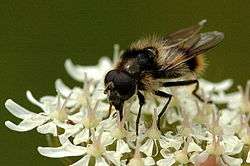Cheilosia illustrata
| Cheilosia illustrata | |
|---|---|
 | |
| male | |
| | |
| female | |
| Scientific classification | |
| Kingdom: | Animalia |
| Phylum: | Arthropoda |
| Class: | Insecta |
| Order: | Diptera |
| Family: | Syrphidae |
| Genus: | Cheilosia |
| Species: | C. illustrata |
| Binomial name | |
| Cheilosia illustrata Harris, 1780 | |
| Synonyms | |
|
Musca illustrata Harris, 1780 | |
Cheilosia illustrata is a species of hoverfly belonging to the family Syrphidae. [1]
Distribution
This common species is present in most of Europe and in the East Palearctic ecozone. [2]
Habitat
These hoverflies can be seen in forest roads, clearings, hedgerows and roadsides.[3]
Description
Cheilosia illustrata can reach a length of 9–11 millimetres (0.35–0.43 in). These hoverflies show a black face, a black scutellum, a band of black hair on the thorax and another on the third tergite. They have a dark area in the middle of the wings and long white hairs at the base of the forelegs and below the scutellum. The antennae are dark. The end of the abdomen is covered with reddish orange hair.[3][4][5]
Biology
They usually feed on umbellifers flowers, particularly on common hogweed (Heracleum sphondylium) and Angelica species. [3] They fly from June to September with a peak during July and August. [6] In autumn the larvae bore galleries into stems of hogweeds and in the roots of parsnip (Pastinaca sativa).[3]
References
- ↑ Biolib
- ↑ Fauna europaea
- 1 2 3 4 Syrphes en Picardie
- ↑ Stuart Ball,Roger Morris Britain's Hoverflies: A Field Guide
- ↑ Nature Spot
- ↑ Stubbs, Alan E.; Falk, Steven J. (1983). British Hoverflies: An Illustrated Identification Guide. British Entomological & Natural History Society. pp. 253, xvpp.
| Wikimedia Commons has media related to Cheilosia illustrata. |